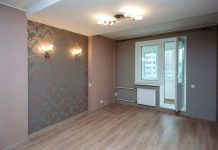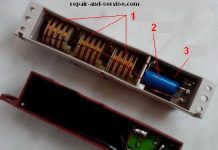A suspended plastic ceiling in a bathroom is one of the best options, so we present to your attention a brief instruction on its installation.
So let's start with the preparatory work. These include purchasing the necessary material and cleaning the ceiling from which the old covering must be removed. For preventive purposes, the entire surface must be impregnated with an antiseptic, even if mold has not previously appeared in the bathroom. From the material you will need a metal profile, suspensions, fasteners for the frame and panels.
Next, we carry out the installation of the frame. First, we attach a galvanized metal profile (more reliable than wooden blanks) to the ceiling at a distance of 50 cm from each other, then suspensions at 60 cm intervals. The suspensions protect the panels from sagging and ensure the stability of the structure.
This is followed by the very fastening of the pvc panels. We cut the details to the width or length of the bathroom (they will be mounted perpendicular to the profile), remove the film, clean the edges.
Following the first, we mount the rest of the panels - until the last one, which may have to be cut. The panels are fastened together with a lock connection.
There are other ways of installing a plastic ceiling, but this one is considered the most practical and rational.
VIDEO
As you can see, to decorate a bathroom with decorative plastic panels with your own hands, you need basic skills in owning a tool and a little free time. A couple of days off - and your bathroom will be unrecognizable!
Bathroom renovation has always been one of the most difficult and painstaking.This is largely due to the cramped space, the presence of water pipes and a bulky bathroom. But there is another important factor that keeps many owners from major or cosmetic repairs - this is the high cost of materials and finishing work. But time and technology do not stand still, due to which new finishing materials appear on the market. One of these materials is plastic panels. Do-it-yourself bathroom repair with panels can be attributed to simple and affordable work, since special knowledge and skills are not required to decorate the walls and ceiling with this material.
Renovation of a bathroom with PVC panels certainly has a number of its advantages. But, like any other building material, plastic panels are not ideal, and therefore, along with the advantages, you need to know about their disadvantages.
The benefits include :
wide range of colors and shades;
moisture resistance. This artificial material is not susceptible to water, mold and mildew, and this is especially important in conditions of high humidity in the bathroom;
ease of installation. All work can be done alone, without special knowledge or skills. For beginners in construction, bathroom renovation with panels is very convenient;
the ability to hide communications. This feature of wall panels allows you to lay pipes or wiring anywhere in the bathroom without disturbing the beautiful design;
the possibility of additional insulation, noise and sound insulation. As in the case of communications, the space between the panels and the wall can be filled with an insulating cake;
unpretentious and easy to care for. The surface of the panels is even and smooth, making them easy to clean;
simple replacement of one or more panels if necessary. Due to the simple method of fixing the panels, if they are damaged, they can be easily replaced with new ones without resorting to large-scale repairs;
low price.
Disadvantages include :
poor resistance to mechanical damage. Unfortunately, plastic panels do not withstand high mechanical loads. But no one is going to deliberately bang something heavy on the walls in the bathroom;
artificial material;
there is a technical smell in the first days after installation. Due to the fact that PVC panels are an artificial material, the chemical industry is engaged in their production. And this, in turn, entails the use of substances with an unpleasant and not very useful smell, which will gradually disappear over time;
when mounting on rails, the usable area of the room is reduced. The advantage of wall panels to hide communications and lay an additional insulating layer is leveled by the fact that this method of installation reduces the useful area of the bathroom. And this is unpleasant, especially for bathrooms with a small area.
As noted earlier, all panel installation work is quite simple and does not require any special knowledge or skills. But before you make a quality repair of the bathroom with panels, you need to find out the features and methods of installing the panels, as well as calculate the materials.
Bathroom renovation with panels - photo
To carry out a bathroom renovation with plastic panels, certain tools and materials will be required.
From materials would need:
plastic panels;
moldings;
wooden planks with a thickness of 10 - 20 mm or a metal profile;
special metal holders;
self-tapping screws, dowels or liquid nails;
special impregnation against mold and mildew;
insulating materials.
From instrument would need:
a hacksaw with fine teeth or a jigsaw (a hacksaw for metal is perfect);
hammer drill or hammer drill;
screwdriver;
level and tape measure.
Important! There are only two ways to mount plastic panels: on liquid nails and lathing.The first option will require a flat surface of the walls and ceiling, but will preserve the usable area of the room. The option of mounting on a crate will allow you to hide communications, make additional insulation, but at the same time reduce the room. Which one to choose is up to the owners to decide directly.
Calculations of the number of panels are quite simple. To do this, you need to know the dimensions of the bathroom in order to calculate the area for finishing. For example, the area to be finished is 7.5 m2. The dimensions of the panel are 0.25 m by 2.7 m, which is equal to 0.75 m2. Now we divide 7.5 / 0.75 = 10 pcs.
Important! When performing calculations, it must be borne in mind that for the beauty of the panels it is better to mount from a single piece. Therefore, to calculate the quantity, you can measure the perimeter of the room minus the doorway and divide it by the width of the panel. It is better to round the resulting value up.
The calculation of the number of panels for the ceiling is performed by dividing the size of one of the sides of the room by the width of the panel. We choose the length of the panel based on the largest size of one of the sides. For example, if the width of the bathroom does not exceed 1.4 - 1.5 m, then you can safely buy panels 3 meters long and cut them in half. And if the largest side is more than 2 m, then panels with a length of 2.6 or 2.7 m should be chosen.
When mounting panels on a frame made of wooden bars or a metal profile, the amount of material should be calculated. To do this, you need to know the perimeter of the room, which, in fact, will be the length for one row of the frame. Further, having measured the height from the ceiling to the floor, we divide it by 0.4 m. It is this step that will be the maximum allowable so that the panels do not bend. We multiply the resulting number of rows by the perimeter, this will be the total length for the frame.
First of all, we carry out cleaning of walls and ceilings from old finishing materials. After that, we treat the surface with a remedy against the appearance of fungi and mold. If you have planned to make a frame made of wood, then we process all the bars with the same tool.
While the bars are drying, we mark the places of their installation on the walls and ceiling. The installation location of the upper bar on the wall will be 5 cm below the ceiling, and the lower one 5 cm higher from the floor or the edge of the bathroom. We keep the same distance on the ceiling with the difference that it will be from the wall. Bars on walls and ceilings should be installed perpendicular to the future panels. That is, if the panels are placed vertically, then the rows of the frame will be horizontal and vice versa.
Now we cut all the bars to the desired length and mark the points for fasteners on them. After that, we apply the block to the mark on the wall and, holding it, drill holes in it so that the marks from the drill remain on the wall. At the points obtained, we drill holes for the dowels. We drive dowels into the holes and fasten the strips to the wall using 6x60 self-tapping screws. Using a level, we make sure that all the planks are in the same plane. If the wall is uneven, then in places of large dips, it is necessary to put a gasket made of wood or other material.
Important! In narrow spaces, such as above a doorway, the frame planks can be placed close together. If it is planned to install additional lamps on the ceiling, then in the places where they are installed, the frame must be reinforced with transverse strips to which the plastic panel will be attached.
Further, if it is planned, insulating materials are laid between the rows of the frame, and you can start installing the panels in place. We begin to mount them from the most prominent corner of the room. First of all, all moldings and panels are cut to length.
Important! The panel has a tongue-and-groove connecting structure.
Then we install a docking corner molding in the corner and insert the panel into it with the side where the groove is located. With a little effort, we drive the panel inside until it stops. It remains to fix the panel to the frame strips.To do this, we use self-tapping screws 3.5x16, which we screw into the protruding spike of the panel. Also, to fix the panels, special metal holders are used, which closely support the panel and are fixed to the frame slats using self-tapping screws or nails. Subsequent panels are installed in the same way. Special moldings are placed in all corners and transitions.
Important! If at the end of the wall the panel does not fit in width, it can be trimmed lengthwise and, after installation, hide the edges with corner molding.
Installation of panels on the ceiling is carried out in the same way. First of all, the corner molding is installed, and in it the first panel. But there is one trick here. Since the ceiling is fully visible, its panels must have a symmetrical shape. Therefore, if you need to trim panels for beauty, you can trim the first and the last so that they are the same width.
The indisputable advantage of mounting ceiling panels on the frame is the ability to install spotlights. The main thing is to separate the wiring in advance and cut holes in the panels for the lamps.
This method of installation is somewhat simpler, but requires high-quality surface preparation. As with the frame mount, first remove all of the old trim. After that, we saturate the wall with a remedy for fungi and mold. Next, we plaster the wall, making its surface as even as possible. The maximum permissible error can be 2 - 2.5 mm.
Now we install the corner molding. We apply liquid nails to the surface of the panel, trying to evenly cover the entire surface. You can take a step of 20 - 25 cm. Then we apply it to the wall and put it into the groove of the molding. Install the subsequent panels in the same way.
These two options for fastening PVC panels can be combined: use liquid nails for the walls, and make a frame for the flow. This will save usable space and at the same time create a beautiful backlight.
Repair of bathrooms and toilets with plastic panels is a simple, affordable and, most importantly, cheap finishing option. Of course, the panels have their weaknesses, but there are probably more advantages. Such a simple and quick repair can be afforded by those with either little time or a limited budget.
VIDEO
If you decide to carry out a long-planned repair of a toilet or bathroom, then you, of course, know that the work of professionals will be quite expensive. Therefore, many make a choice in favor of do-it-yourself repairs. Having a great desire and financial capabilities, you can choose the option with plastic panels. In addition, the installation of PVC panels in the bathroom is within the power of a person who has never encountered repair work. Especially if you know how to fix the panels in the bathroom with your own hands step by step and what is needed for this.
Experts recommend starting repairs with surface preparation, where the frame or plastic materials will be attached. This primarily applies to old plaster, which can slightly expand the space between the wall and the panel. In addition, with the frameless method of fastening, the walls will need to be treated with plaster in order to exclude possible irregularities, and if the presence of small depressions is not prohibited, then large bulges are unacceptable.
With any method of fastening with your own hands, the walls must be treated with special solutions with antifungal effect.
The better the walls of the room are processed, the less likely it is that fungus or mold will form on them. Therefore, it is not worth saving on them, it is better if you go to a hardware store to purchase them.
If the bathroom has not been renovated for a long time, then just now it is necessary to start replacing the metal communication pipes.If your repair involves replacing or installing sockets in the bathroom, then before fixing the material, take care of supplying electricity to them.
Plastic panels can be installed by hand using two mounting methods:
To make it easier to navigate which method of fastening to give preference, here are a few differences between the two methods of fastening:
the metal frame takes up a lot of useful space, which is so critical for placing a toilet or bathroom;
the metal frame consists of separate profiles, so the installed plastic has voids under it that are easy to push;
in the case of the frame fastening method, there will be a void between the wall and the plastic in which various microorganisms will develop;
to make a frame for plastic panels, you will need to purchase metal profiles and various fasteners, while for a frameless method, you will only need glue liquid nails.
For cladding with a frame method, you will need:
cladding panels for the bathroom;
guide rails for lathing;
finishing profiles made of plastic;
plastic corners;
ceiling and floor plinth for the bathroom;
hacksaw;
self-tapping screws;
dowels;
puncher;
Phillips screwdriver or screwdriver.
For cladding in a frameless way, you need to prepare:
If you decide to do the cladding of a toilet or bathroom with your own hands, using a frameless method of fastening, in addition to preparing glue, liquid nails, you need to carry out some preparatory work. The most important point when performing these works is the preparation of the foundation.
In this case, we are not talking about a perfectly flat wall surface, differences of up to 3 mm are allowed. There should be no hills at all, and shallow depressions are allowed. To correct visible defects of the wall, plaster or putty it.
The next, important point, in the frameless method of fastening, is to work with the corners of the room. Most city apartments have slightly rounded corners, in the case of plastic, such corners will create additional difficulties when installing panels. To correct these shortcomings, you can use a punch and make the corners expressive.
It remains to prime the surface of the walls and you can start fixing the panels. For these works, you will need to stock up on liquid nails glue. Having calculated the area of the toilet and bathroom, calculate how much glue liquid nails you will need if its consumption, on average, is 1 cylinder per 5 square meters.
Having prepared the panel of the desired size, you need to apply liquid nails to it pointwise, placing the glue sections in a checkerboard pattern. Close to the edges, liquid nails are not applied, since, by attaching the panel to the wall, excess glue will come out, smearing the front side of the coating.
With the smeared side, the panel is applied to the wall, and pressed with a palm over the entire area. Then the material is torn off the wall and the liquid nails are allowed to dry for about 5-7 minutes. After 5-7 minutes, the strip is returned to the wall and pressed over the entire surface. This laying technology is not an invention of builders, but the specifics of working with glue liquid nails. If you ignore this technology, then the installed panels can easily move and the installation process will be disrupted.
Particular attention in this work is paid to the fastening of the first panel. To do this correctly, you need to use the level. And in order to avoid shifts of the strip in the process of laying the remaining strips, dowels or self-tapping screws are hammered at the bottom and top. In the finished version, their places of installation will not be visible, since they are usually covered with ceiling and floor skirting boards.
Don't forget about starter strips and corner joints. It is recommended to install them in the places where they are really needed. If the room of the toilet or bathroom will be equipped with a floor plinth, then you should not remember the starting profile.
The plinth well strengthens the fastening of the panel at the bottom, and the frame - of the ceiling at the top, therefore, it is not recommended to start repairs with cladding elements from the ceiling.
You can also mount plastic panels with your own hands in a frame way. The work begins with the installation of horizontal plastic guide rails, along the entire perimeter of the wall. To do this, you need to mark the walls to install metal profiles. Using a punch, drill holes in places on the marking, drive in dowels there and, attaching the guides to the wall, attach them using self-tapping screws.
At the same time, it is not recommended to use wooden panels, since it will not be possible to achieve perfect joints, which will lead to the destruction of the wooden frame due to constant humidity. The frequency of the horizontal battens depends on how strong you want the cladding, but in general it is customary to use the following distances:
when facing the ceiling - 30-40 cm;
when facing walls - 40-50 cm.
In this case, the distance of the first and last slats from the floor surface should be about 5-7 cm. And the end parts of the profiles should exactly fit into the corners of the room. The slats of the future frame must be fixed perpendicular to the panels to be installed. In most cases, the panels are placed vertically, which means that the slats should be perpendicular to them and parallel to the floor. The vertical arrangement of the panels not only visually increases the height of the ceilings, but also better removes the accumulated moisture, since water drops will flow down, and with horizontally installed panels, water will linger on them.
After completing the frame, you can start attaching the panels, but how to do it correctly? The panels must be mounted on the frame using self-tapping screws, which can be easily screwed into them. In this case, you need to start from the corner farthest from the front door. To avoid moisture penetration between the panels, it is recommended to seal their joints with a sealant.
In order for the panels to fit beautifully in the corners of the room, it is necessary to use such a device as an external and internal profile, which in appearance resembles the English letter L. At the junction with the floor, you can use a plinth, then an additional profile is not required.
Having installed the side profile, one panel is inserted into it, and it is fixed to the frame rail. The rest of the panels are inserted into the gaps of the previous one, very tightly. If you have provided an outlet on the wall of the toilet or bathroom, then you need to cut a suitable hole on the panel to be installed and install it against the wall.
To give the room a more complete look, after installing the panels, attach the floor and ceiling skirting boards, in addition to the aesthetic function, they will also perform a practical one, hiding minor flaws.
Video (click to play).
To work quickly, you should heed the advice of experts:
if the room of the toilet or bathroom is small, then repair with lining is recommended to be carried out in light colors in order to visually increase its area;
If you want your toilet or bathroom renovation to look spectacular and unique, use panels of various sizes or colors for cladding. As a design, you can take panels with pictures, but here the main thing is to harmoniously dock them;
before you start cladding the room with your own hands, bring the purchased panels into the bathroom and leave them there for about an hour to avoid deformation;
you need to fasten the material from the farthest corner from the front door, in this case you can perform the most prominent places without errors and flaws;
before making repairs with your own hands, look at all problem areas where pipes or plumbing are located, this will help to quickly install the frame and plastic panels. For the frame, we usually make markings, observing the horizontal and vertical lines along which you will fasten the crate;
to mask water and drain pipes in the toilet, it is recommended to make a blende panel, which will only improve the interior design.

Rice.Fastening panels to rails using special brackets
Rice. We fasten the panel to the metal guide using a self-tapping screw










 Rice.Fastening panels to rails using special brackets
Rice.Fastening panels to rails using special brackets  Rice. We fasten the panel to the metal guide using a self-tapping screw
Rice. We fasten the panel to the metal guide using a self-tapping screw










